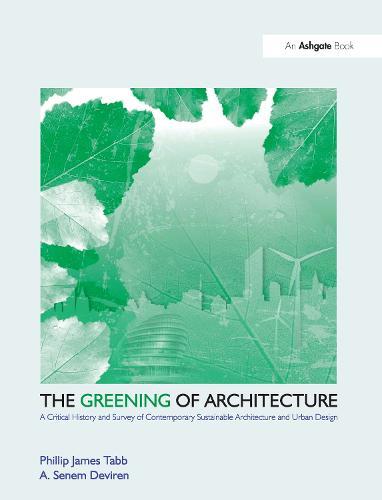Overview
Contemporary architecture, and the culture it reflects dependent as it is on fossil fuels, has contributed to the cause and necessity of a burgeoning green process that emerged over the past half century. This text is the first to offer a comprehensive critical history and analysis of the greening of architecture through accumulative reduction of negative environmental effects caused by buildings, urban designs and settlements. Describing the progressive development of green architecture from 1960 to 2010, it illustrates how it is ever evolving and ameliorated through alterations in form, technology, materials and use and it examines different places worldwide that represent a diversity of cultural and climatic contexts. The book is divided into seven chapters: with an overview of the environmental issues and the nature of green architecture in response to them, followed by an historic perspective of the pioneering evolution of green technology and architectural integration over the past five decades, and finally, providing the intransigent and culturally pervasive current examples within a wide range of geographic territories. The greening of architecture is seen as an evolutionary process that is informed by significant world events, climate change, environmental theories, movements in architecture, technological innovations, and seminal works in architecture and planning throughout each decade over the past fifty years. This time period is bounded on one end by the awareness of environmental problems beginning in the 1960's, the influential texts by Rachel Carson, E.F. Schumacher, Buckminster Fuller and Steward Brand, and the impact of the OPEC Oil Embargo of 1973, and on the other end the pervasiveness of the necessary greening of architecture that includes, systemic reforms in architectural and urban design, land use planning, transportation, agriculture, and energy production found in the 2000's. The greening process moves from remediation to holistic models of architecture. Geographical landscapes give a global account of the greening process where some examples are parallel and sympathetic, and others are in clear contrast to one another with very individuated approaches. Certain events, like the Rio Summit in 1992 and Kyoto Protocol in 1997, and themes, such as the Hannover Principles in 2000, provide a dynamic ideological critique as well as a formal and technical discussion of the embodied and accumulative content of greening principles in architecture.
Full Product Details
Author: Phillip James Tabb ,
A. Senem Deviren
Publisher: Taylor & Francis Ltd
Imprint: Routledge
Edition: New edition
Dimensions:
Width: 18.90cm
, Height: 1.20cm
, Length: 24.60cm
Weight: 0.476kg
ISBN: 9781409447399
ISBN 10: 1409447391
Pages: 216
Publication Date: 24 January 2014
Audience:
College/higher education
,
Professional and scholarly
,
Postgraduate, Research & Scholarly
,
Professional & Vocational
Format: Paperback
Publisher's Status: Active
Availability: In Print

This item will be ordered in for you from one of our suppliers. Upon receipt, we will promptly dispatch it out to you. For in store availability, please contact us.
Reviews
'As a whole, the book lies somewhere between a textbook and an extended essay on green architecture and provides a general survey of the physical aspects of green and sustainable design ... The most useful contribution of the book is the exposition of the multiple ideas and projects that have inspired and informed green and sustainable design approaches ... By highlighting the complex and dynamic trajectory of green and sustainable design over the last half century, the authors provide inspiration for how these practices might evolve and expand in the twenty-first century'. LSE Review of Books ' ... highlight[s] unique architectural practices and socially oriented architecture/planning for working in natural contexts with rural vernaculars ... examines the 1960's through 2010 for the development of awareness and for technologies supporting sustainable design and expanding the diversity of sustainable thinking. Recommended. Upper-level graduates and above.' Choice '... a thoroughly researched and documented, seminal volume on the emergence and evolution of the contemporary movement towards the greening of architecture, ...from the visionary and technological explorations of the 1960's to the more biophilic and infrastructural green propositions of today. Together, they also draw from the lens of their own extensive knowledge of sustainable design principles and the nature of place making to provide a narrative that is scholarly, engaging, and very accessible'. Roberto Chiotti, Larkin Architect Limited and OCAD University, Toronto
'As a whole, the book lies somewhere between a textbook and an extended essay on green architecture and provides a general survey of the physical aspects of green and sustainable design ... The most useful contribution of the book is the exposition of the multiple ideas and projects that have inspired and informed green and sustainable design approaches ... By highlighting the complex and dynamic trajectory of green and sustainable design over the last half century, the authors provide inspiration for how these practices might evolve and expand in the twenty-first century'. LSE Review of Books ' ... highlight[s] unique architectural practices and socially oriented architecture/planning for working in natural contexts with rural vernaculars ... examines the 1960's through 2010 for the development of awareness and for technologies supporting sustainable design and expanding the diversity of sustainable thinking. Recommended. Upper-level graduates and above.' Choice
Author Information
Phillip James Tabb is a Professor in the School of Architecture, Texas A&M University, USA and Dr A. Senem Deviren is an Associate Professor at the School of Architecture, Istanbul Technical University, Turkey.




